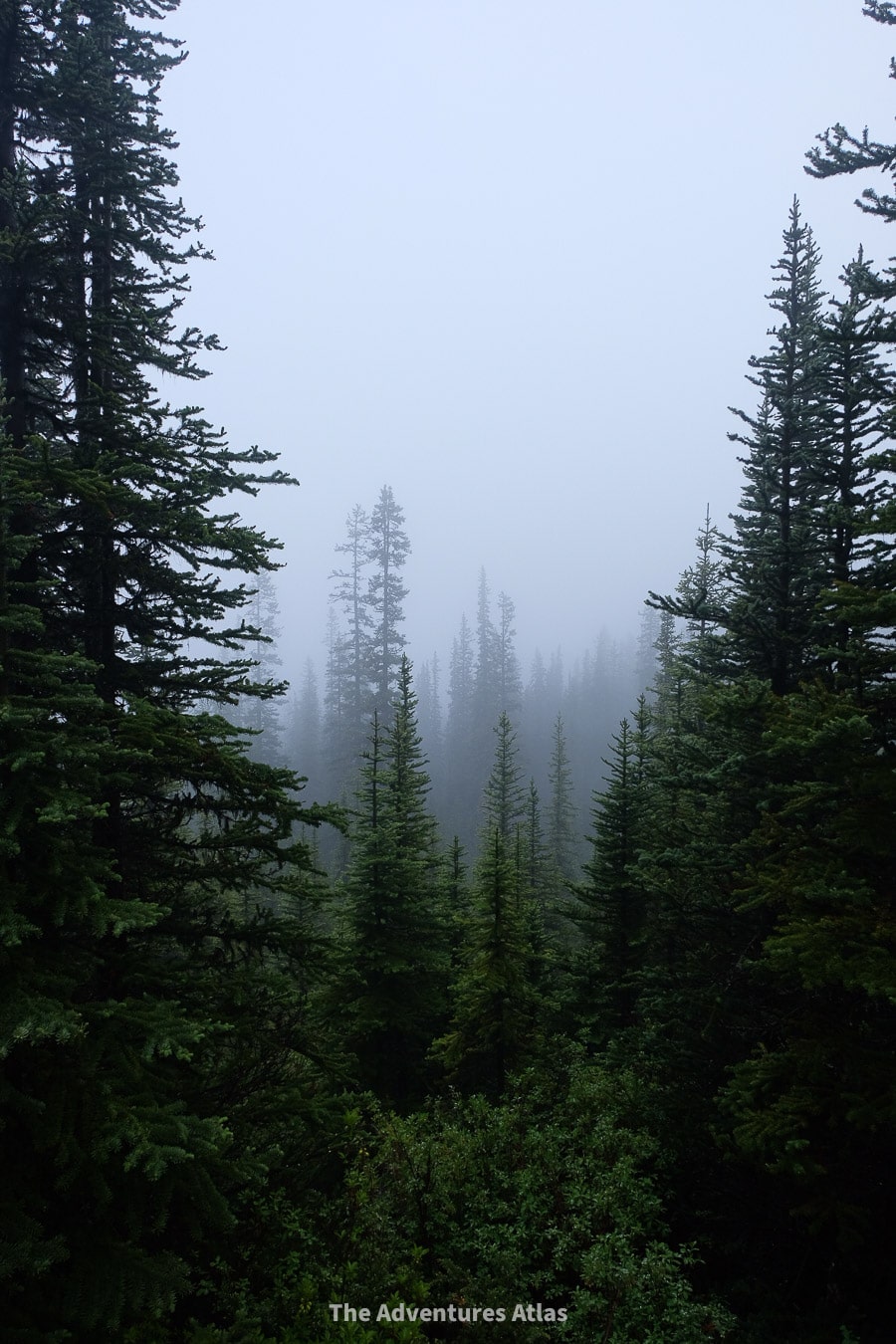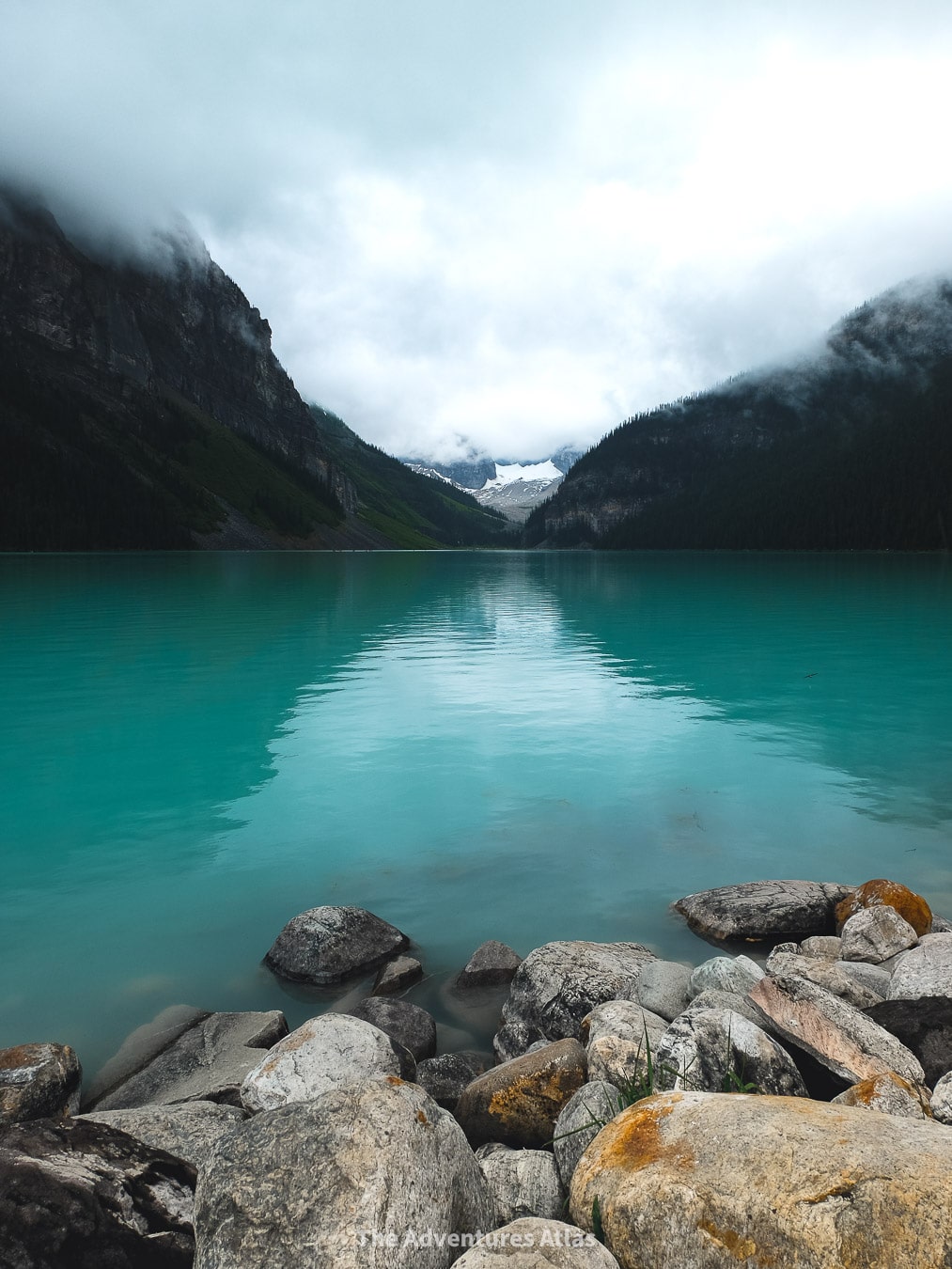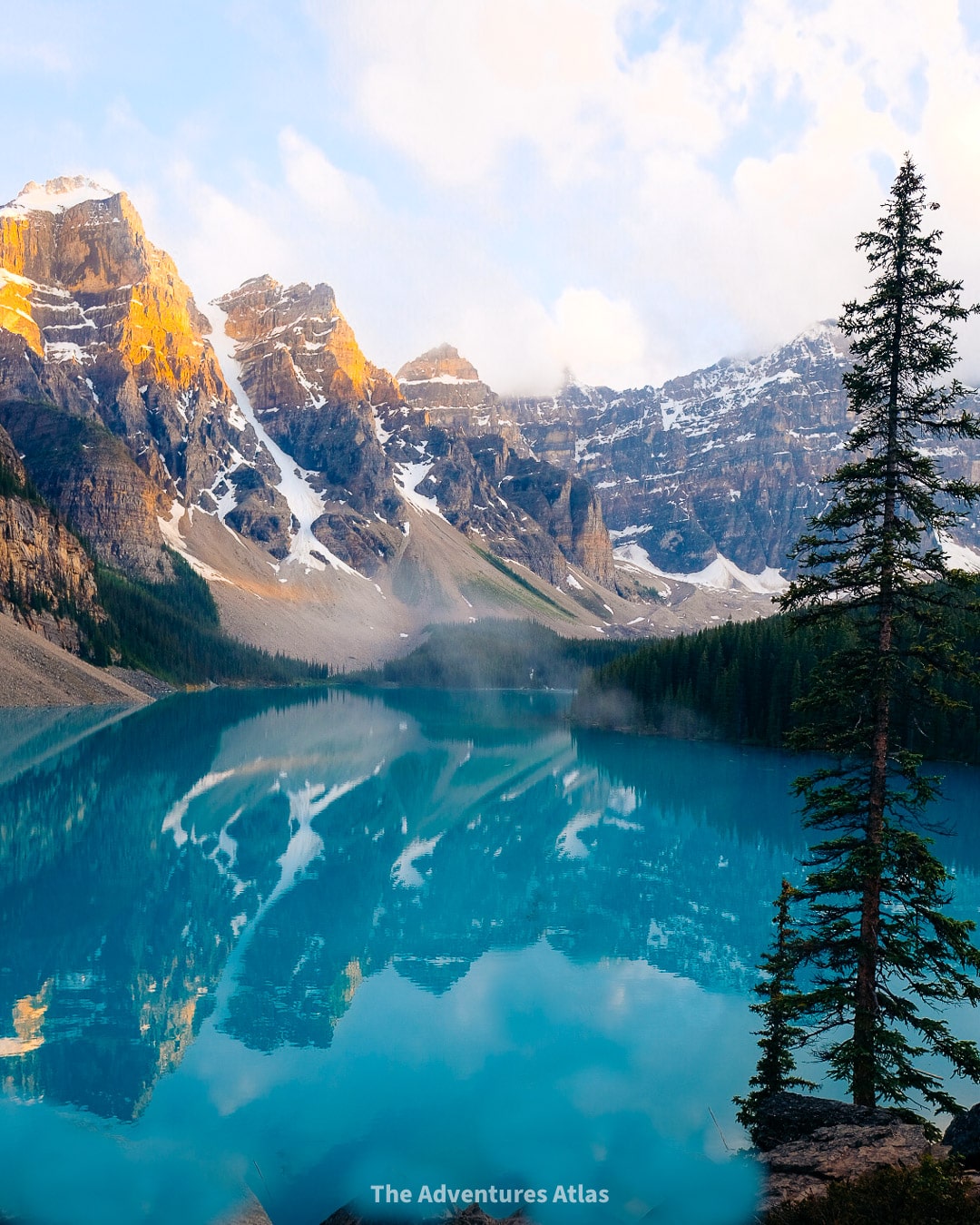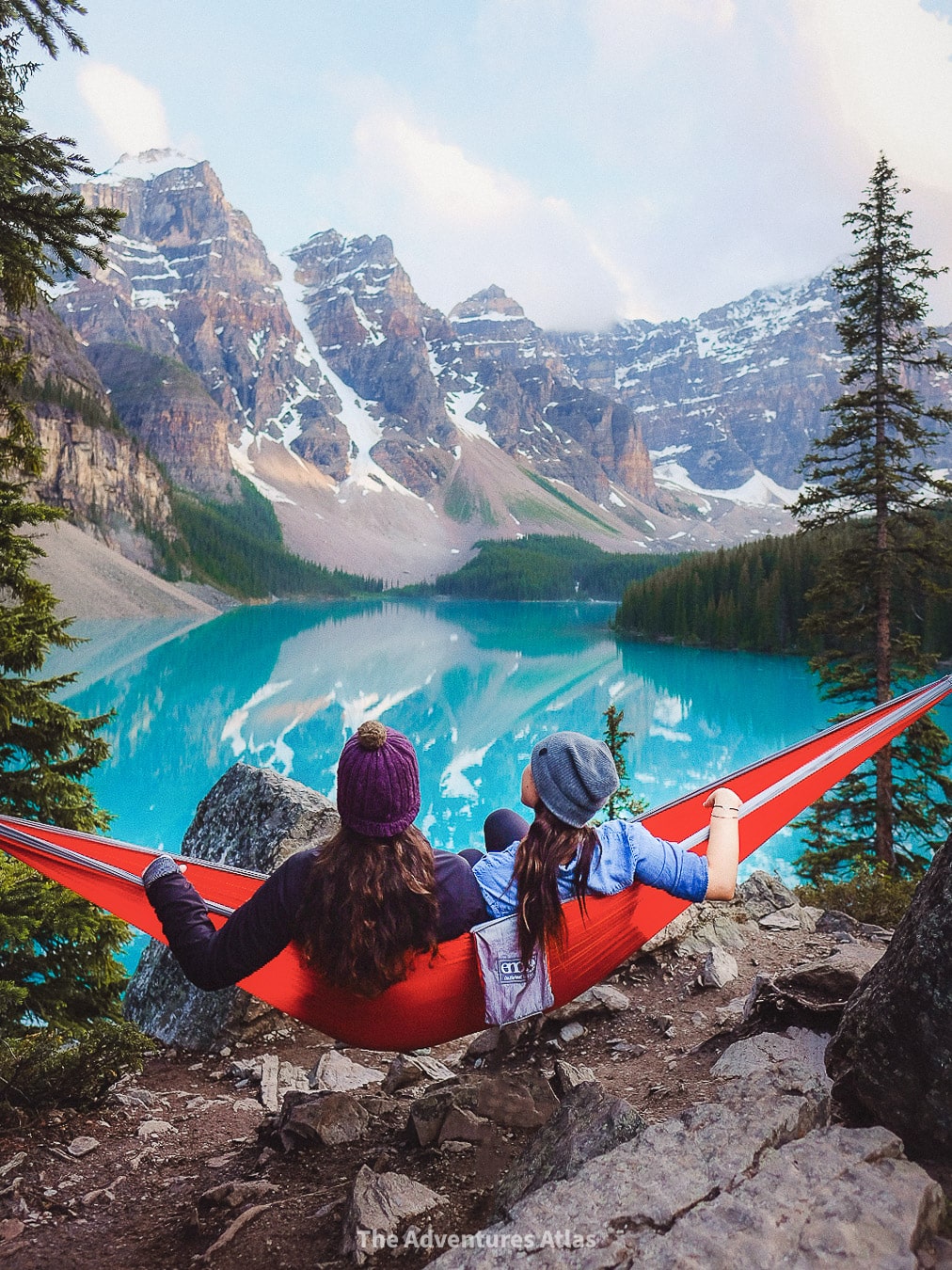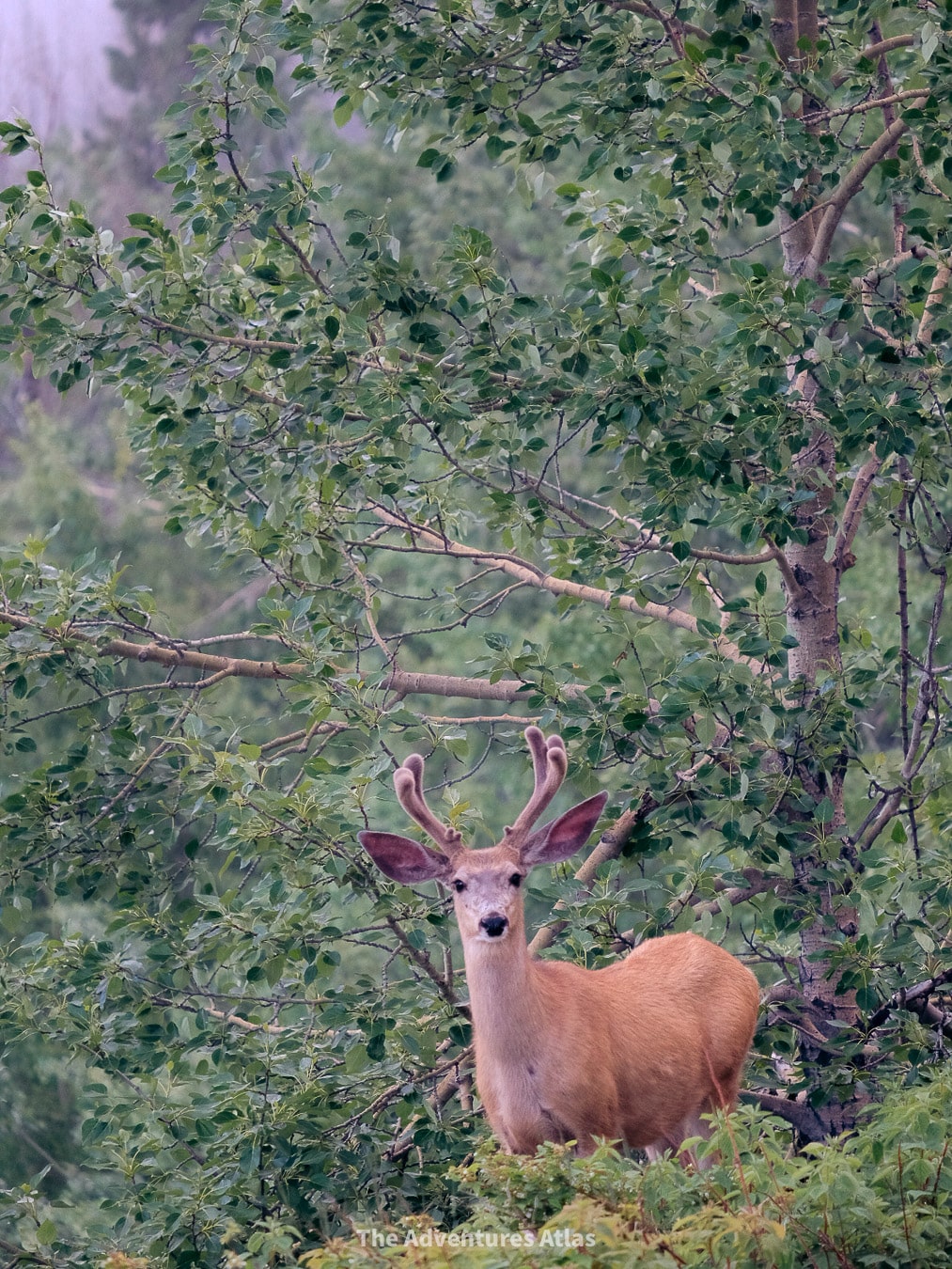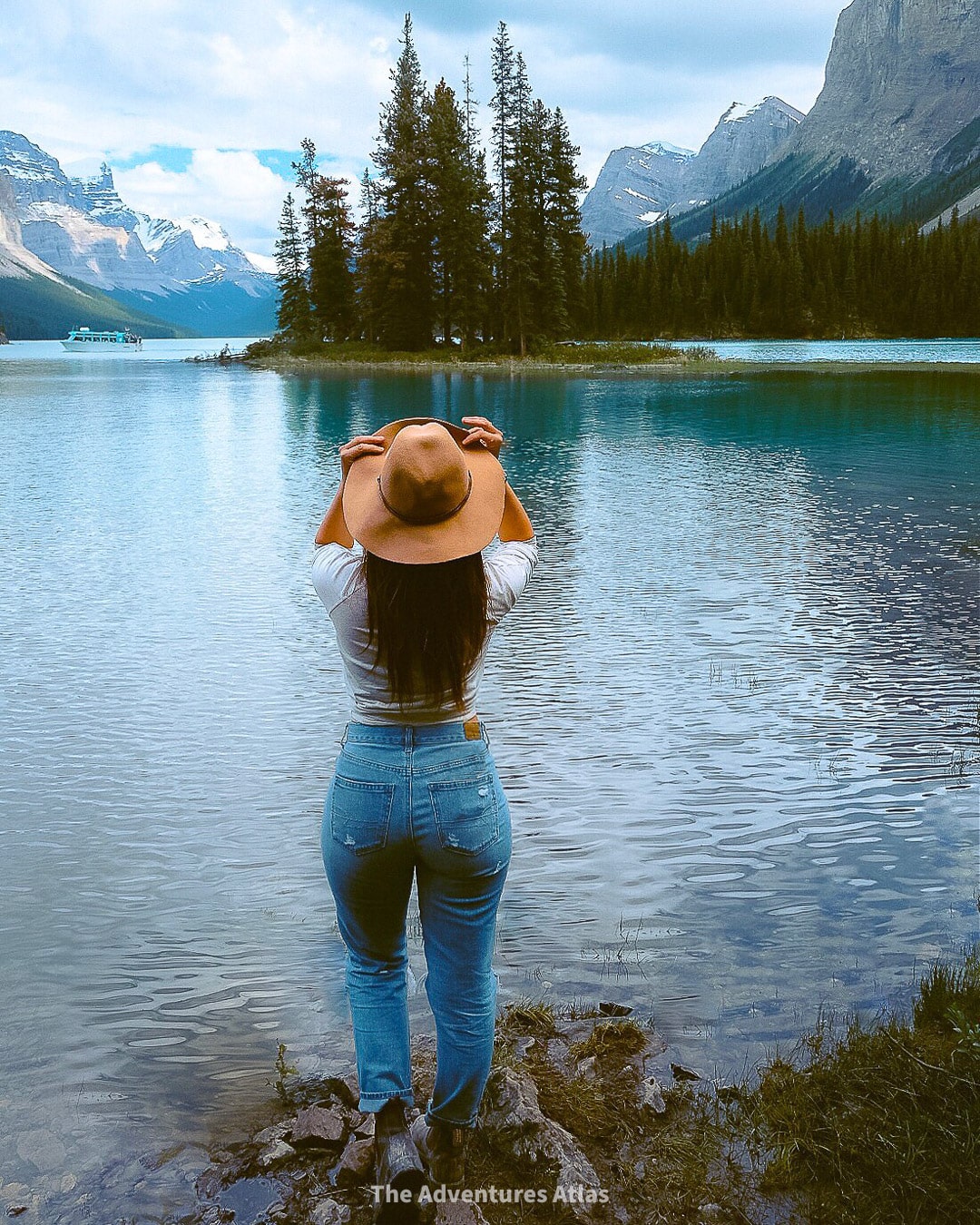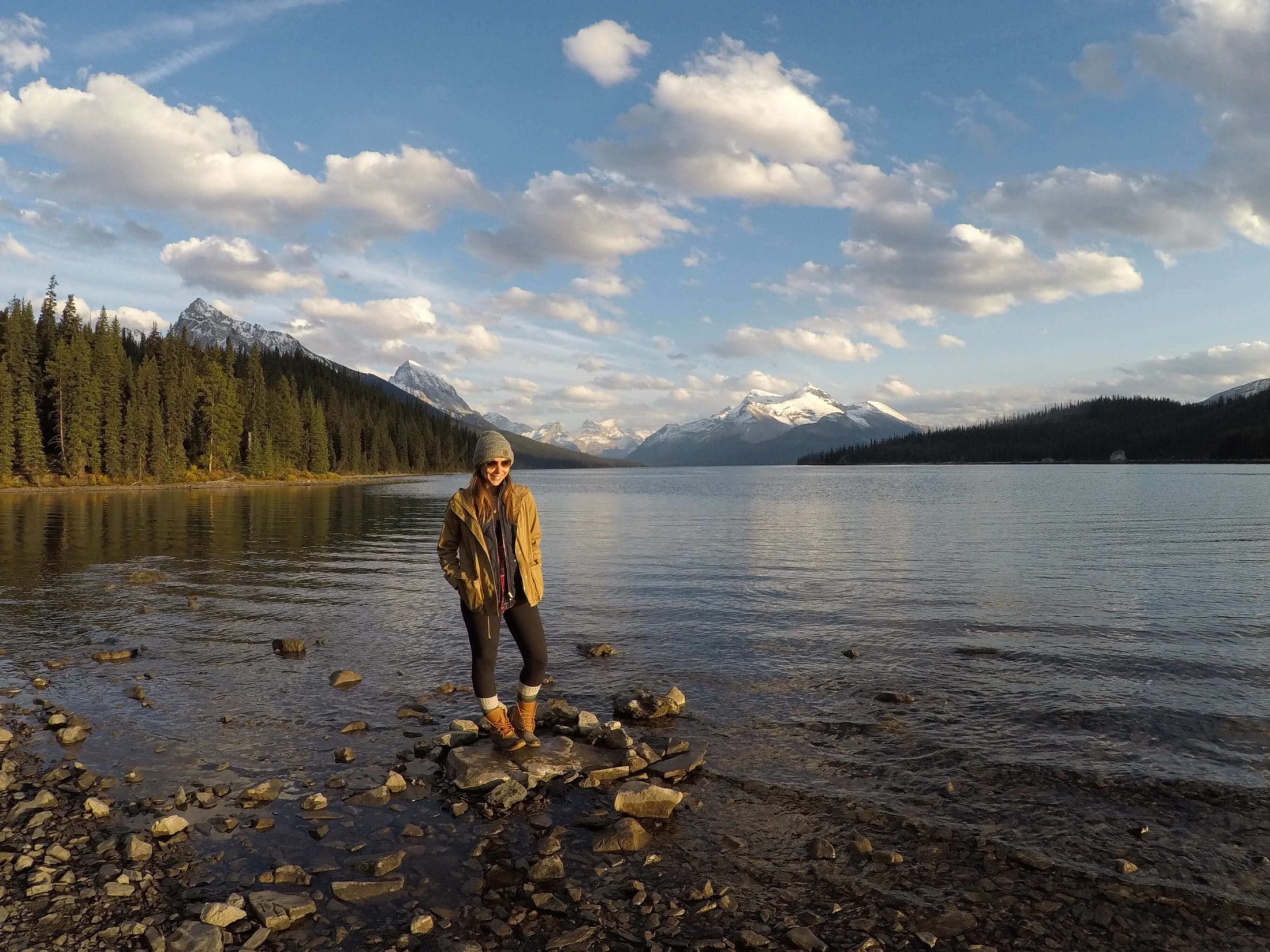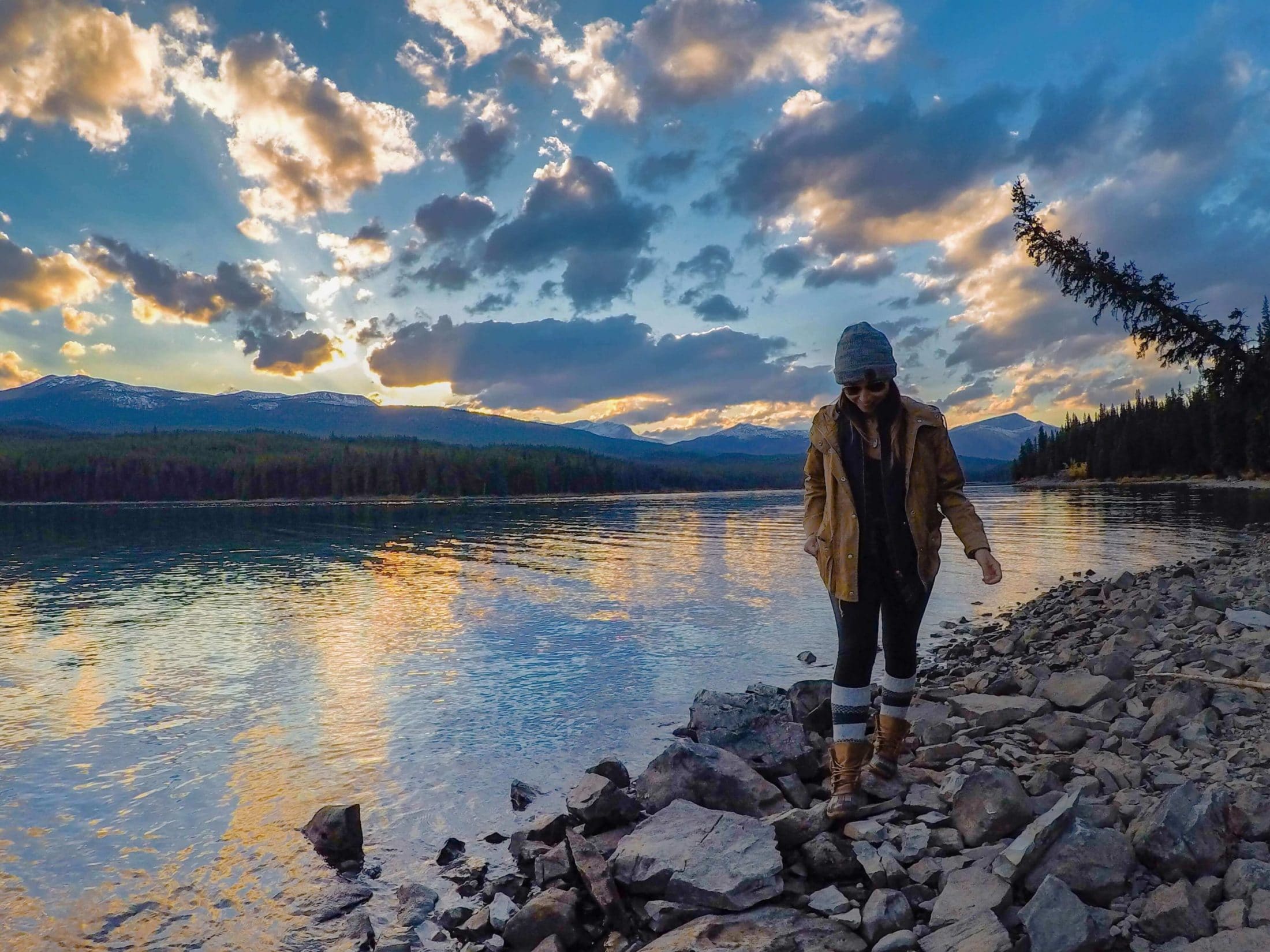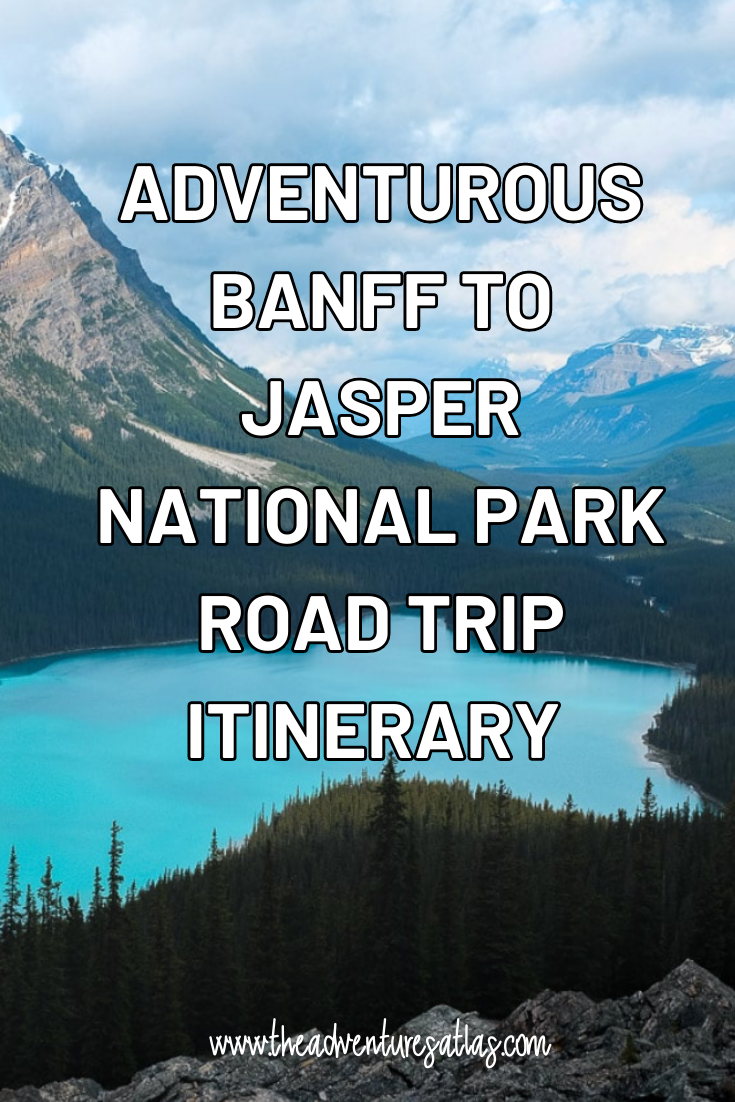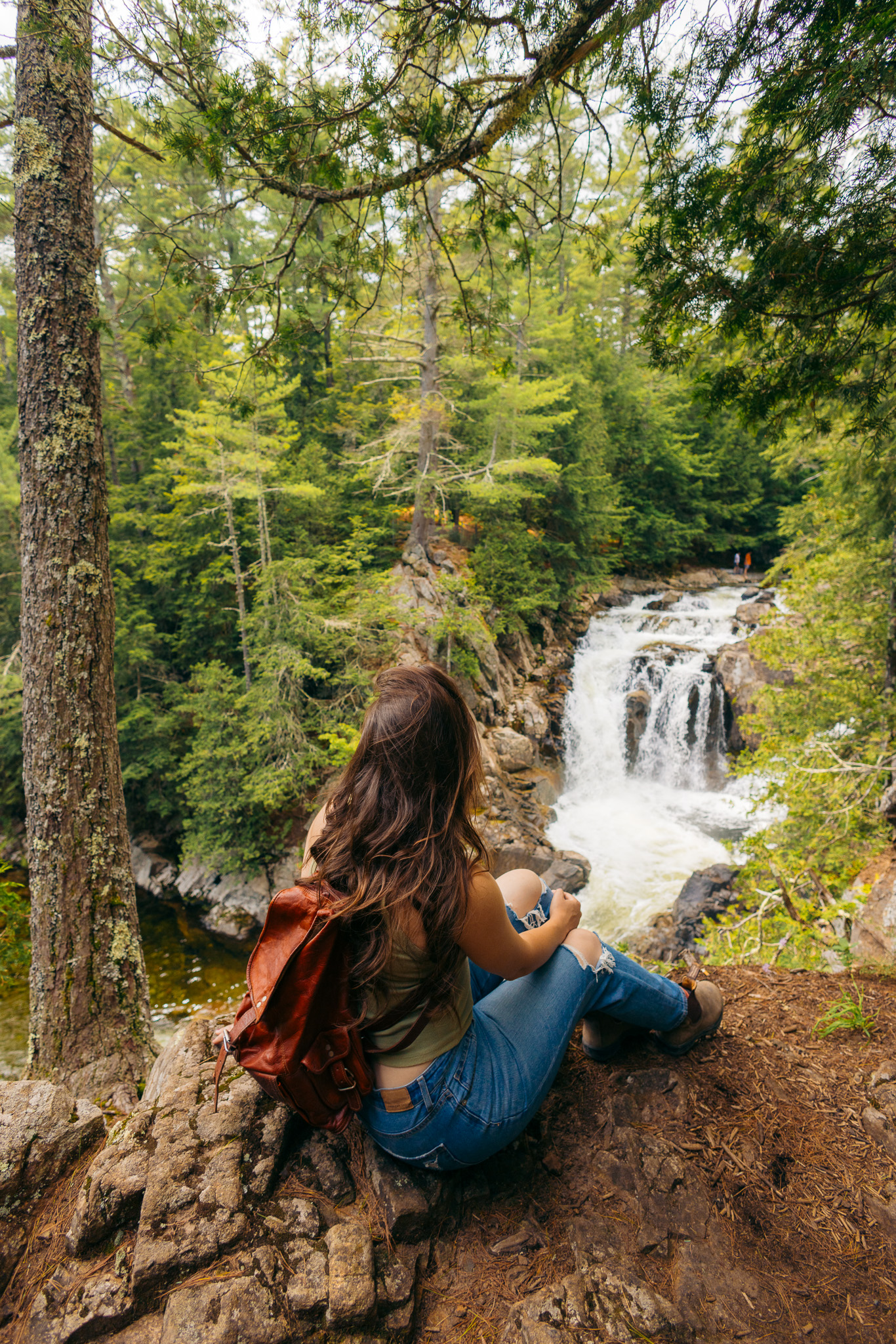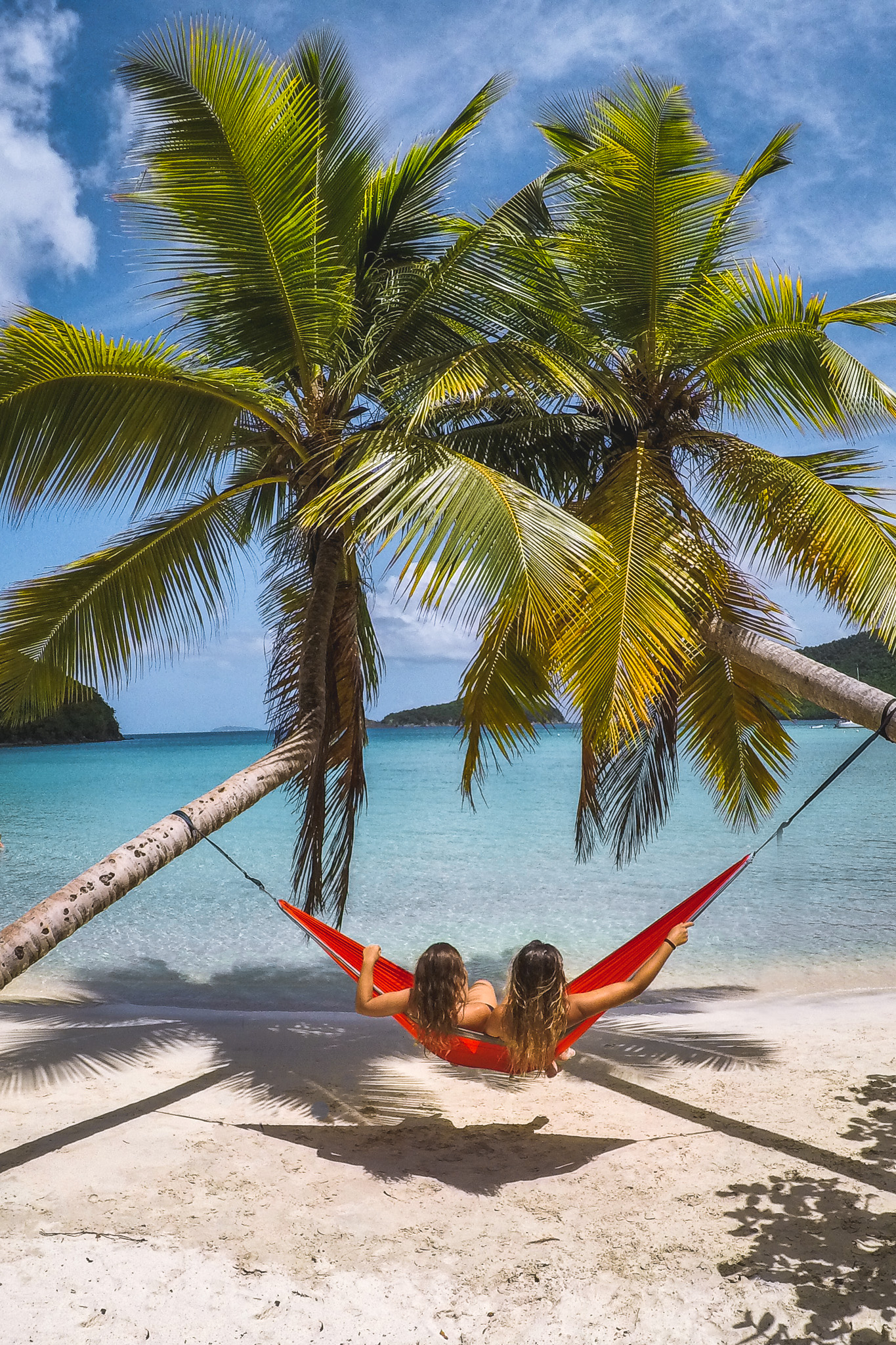The Best Banff Itinerary: A 1 Week Road Trip from Banff to Jasper National Park
Post summary: A complete travel guide for Banff National Park and the perfect Banff itinerary for a 1 week Banff to Jasper road trip
This post contains affiliate links, which means that I will make a small commission of the purchase you make using my links – at absolutely no cost to you!
Maybe you’re planning your trip to Banff or you’re already there and trying to find the best things to do. Either way – you’re in the right place!
Banff is a truly jaw dropping travel destination with so many things to do that it can be hard to decide what to include in your itinerary. To help you narrow it down, we put together the best things to do in Banff National Park and the best itinerary for a Banff to Jasper National Park road trip. While 1 week is hardly enough time to scratch the surface of all the incredible things to see here, this 1 week Banff itinerary does the best job at squeezing in all the highlights – and then some!
This 1 week Banff to Jasper road trip has it all: towering ice-capped peaks, icy-blue glacial lakes, castles, hot springs, glacier hikes and more.
In this post, we’re covering the best way to spend a week in Banff National Park and Jasper National Park in Alberta, Canada on an epic 7 day Banff to Jasper road trip.
Here’s what you’ll find in this post:
Posts to help you prepare for your Banff to Jasper road trip!
How to Travel Banff on a Budget
How to Use Google Maps to Plan Your Next Road Trip (Step-By-Step Tutorial With Examples)
15 Useful Apps to Download Before Your Next Road Trip (for Free!)
What to Pack for a Day Hike: Essential Gear and Complete Packing List
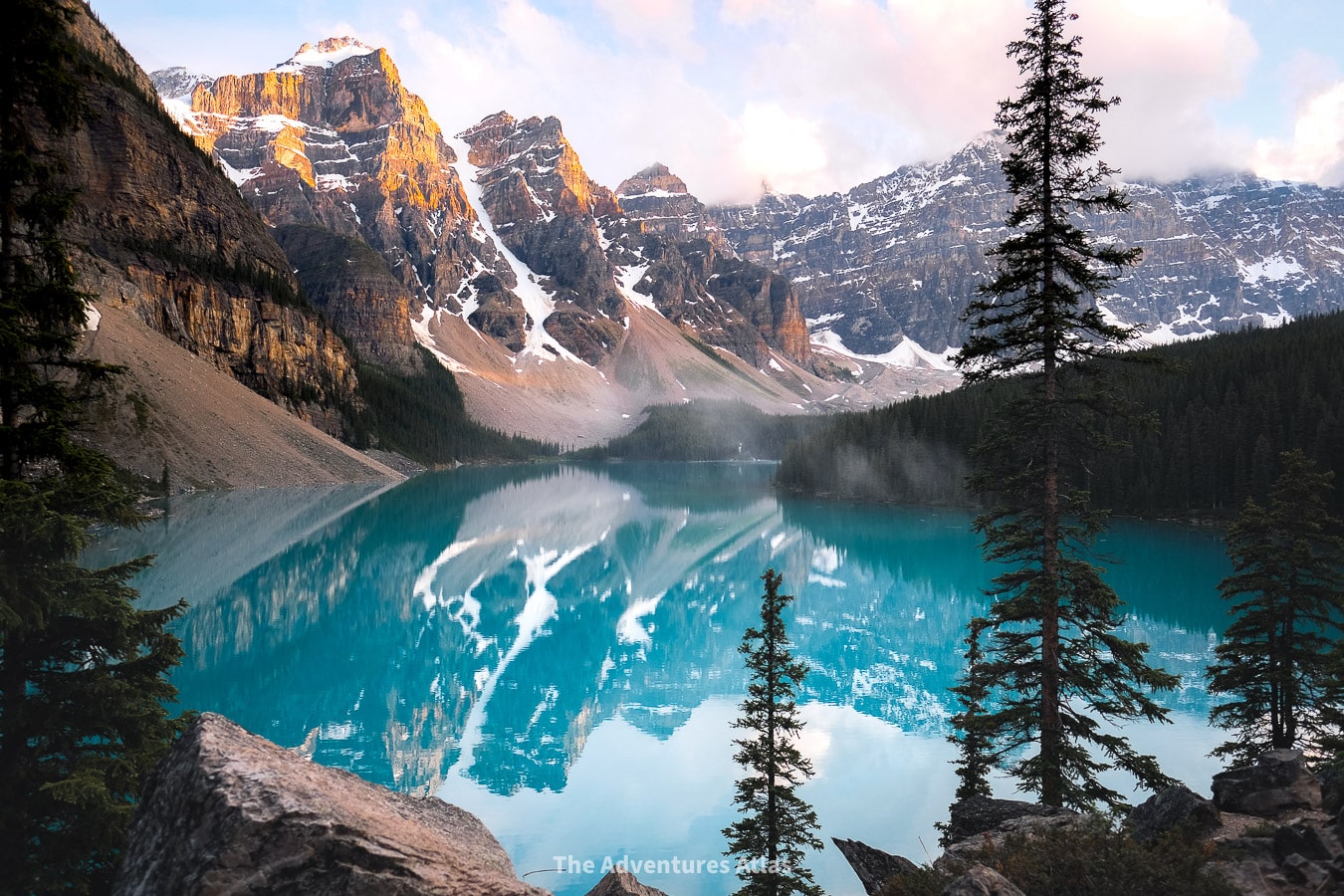
Banff to Jasper: The 1 Week Road Trip Overview
The Canadian Rockies are mesmerizing and encompassed within the westward provinces of Alberta and British Columbia. Much of the range is protected within National and Provincial parks, which just so happen to make the perfect escape for anyone in need of some inspiration, soul searching, or just a serious reset.
This itinerary gives you a total of 3 days in Banff, 1 day exploring the Icefields Parkway and 2 days in Jasper National Park. It’s based on several of my own road trips through Banff and Jasper National Parks over the years, places I know you’ll love, and things I wish I would have done differently.
This itinerary starts and ends at Calgary International Airport (YYC) in Calgary, Alberta Canada. From Calgary, head north to explore Banff National Park and then drive the Icefields Parkway to Jasper National Park, before heading back for one more day in Banff.
The best way to get around on this Banff to Jasper itinerary is with a rental car or a camper van. You can rent a car when you land at the Calgary airport. If you prefer to live the #vanlife, you can browse a huge selection of camper vans for rent through RVezy.
Here’s a quick overview: Click here to view the interactive map in Google Maps.
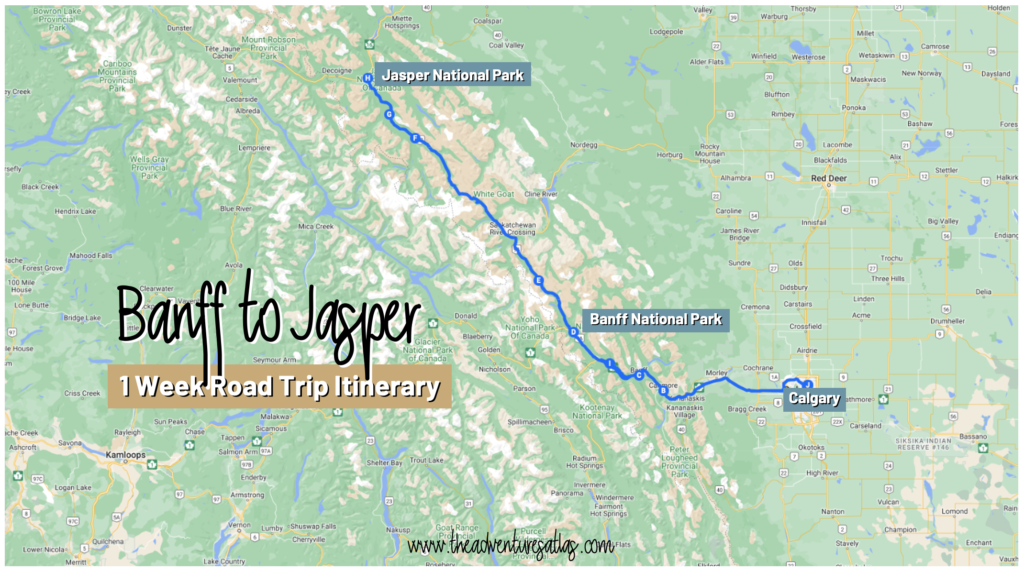
Day 1: Arrive in Canmore near Banff National Park
Day 2-3: Banff National Park
Day 4: Drive the Icefields Parkway to Jasper National Park
Day 5: Jasper National Park
Day 6: Athabasca Glacier and drive back to Banff National Park
Day 7: Johnston Canyon via Bow Valley Parkway
Estimated total drive time: 17 hours
Estimated total miles for this route: 569 miles (915 km)
Banff Itinerary Day 1: Arrive in Canmore
This 1 week Banff itinerary starts in Canmore, a small town about 20 minutes south of Banff National Park.
Some people prefer to be close to the action and stay directly inside Banff National Park. However, Canmore is actually the perfect home base to explore Banff on this Banff itinerary because it’s a lot more affordable and much less touristy than downtown Banff. By staying in Canmore, you will have a much more authentic experience without the hustle and bustle of staying in Banff.
Another thing that’s super convenient is that you can leave your car parked at your hotel in Canmore while you explore Banff. Simply take the Canmore-Banff Regional Service, which provides quick and convenient transport between Canmore and Banff town. That way you don’t have to worry about finding parking in Banff town, which can be a serious nightmare sometimes.
If you arrive early and want to stretch your legs, pick from this list of the best things to do in Canmore:
- Stop by Lake Minnewanka
- Hike the Grassi Lakes Trail
- Drive the Smmith Dorrien Trail
- Walk Policeman’s Creek Boardwalk
- Drive the Three Sisters Parkway for amazing views of the Three Sisters
Where to stay in Canmore
There are tons of hotels, lodges, and Airbnb’s clustered around the town. A night at a hotel in Canmore during the high season typically costs around $200 – $300 per night and goes up from there. If you book ahead of time, you shouldn’t have any problem finding a place to stay in and around Canmore.
Lodging prices skyrocket the closer you get to Banff National Park. If you do prefer to stay in the town of Banff instead, book your accommodation well in advance. I’m talking like 6-8 months out. Even for hostels, like Samesun Banff and Banff International Hostel!
View all stays in Canmore here.
- Splurge ($$$): The Malcom Hotel; Fairmont Banff Springs
- Moderate ($$): Basecamp Resorts Canmore; Tamarack Lodge; Stoneridge Mountain Resort
- Budget ($): HI Canmore Hostel
Budget travel tip: For ultra-budget travel, check out Airbnbs in the town of Cochrane, Alberta. It’s about an hour south of Banff, which adds a bit of a drive. But if you are on a really tight budget, it might be worth it because you can find cozy Airbnbs for about $100 per night in the high season.
Camping in Banff National Park
Camping is the most affordable option for lodging in Banff National Park. If you don’t mind roughing it, camping is the best way to save money, surround yourself with nature, and enjoy incredible views of the Canadian Rockies.
There are 13 campgrounds in Banff National Park. Most of them are first-come-first-serve but it’s possible to reserve some sites online on the Parks Canada website.
Most of the campgrounds are only open mid-June to October. The campgrounds fill up incredibly fast, especially between June – September, so make any reservations well in advance. If you don’t have a reservation, make sure to show up early to find a spot as people are leaving.
View all Banff campsites here.
Day 2: Lake Louise in Banff National Park
Banff National Park was established in 1885, making it Canada’s oldest national park. Its home to almost 3000 square miles of breathtaking, pristine mountainous wilderness, teeming with wildlife.
Day 2 of your Banff itinerary brings you to Lake Louise.
If you’ve ever seen pictures of Lake Louise, you’ve probably seen the view looking out from shore. The water rippling over white rocks, fading seamlessly from the palest blue to a deep turquoise at the foot of the surrounding mountains.
What you probably didn’t see were the crowds of tourists and the massive luxury hotel situated on the shore. It’s the textbook example of Instagram vs. Reality – so be prepared! But the lake is breathtaking and an absolute must-see, nonetheless.
Parking for Lake Louise is available in the lot by the resort. While the lot is large, it usually completely fills up by 7:30AM, so get there as early as you possibly can.
Stop 1: Little Beehive via the Lake Agnes Tea House
No Banff itinerary is complete without a hike up Little Beehive. Little Beehive is one of the best hikes in Banff and leads to jaw dropping views of Lake Louise.
Little Beehive Hike details:
- Distance: 5.7 miles RT (out and back)
- Elevation gain: 1,955 ft
- Difficulty: moderate
- Time to hike: 3.5-4 hours
- This hike is recommended between mid-October and mid-June due to risk of avalanches. Tea house is closed from October – June.

The trail to Little Beehive is well maintained through dense coniferous forest. It’s a pretty steady climb the entire way up, but there are several scenic stops where you can take a break, like Mirror Lake and Lake Agnes.
Frequent breaks in the treeline give you small glimpses of the lake below as you climb in altitude.
At the summit, you’re rewarded with unspoiled views of Lake Louise and the surrounding peaks in Banff National Park. From above, the color of the lake turns a brilliant opaque turquoise, appearing as though someone colored it with a crayon.
On the way back down, stop for a light lunch at the Lake Agnes Teahouse. The line to the teahouse starts getting long around 11AM, so if you get there around lunch time, prepare to wait.

Here are some other amazing hikes around Lake Louise:
- Lake Louise Lakeshore Trail
- Big Beehive
- The Plain of Six Glaciers Trail
- Larch Valley and Sentinel Pass
Tip: Up for a challenge? Combine Lake Agnes Tea House, Big Beehive, The Plain of Six Glaciers (via the Highline trail), and the Lake Louise Lakeshore Trail for one epic full day hike that has a little bit of everything! This route clocks in at roughly 22km with 1,030m (ft) elevation gain.
Stop 2: Canoeing on Lake Louise
A visit to Banff National Park is hardly complete without a paddle across Lake Louise!
When you’re done exploring Lake Louise from above, head down to the dock at the lake shore to explore it from down below. The view from the water is absolutely magnificent as you paddle across the turquoise water with views of Victoria Peak and the Victoria Glacier out in front of you.
The dock is run by Fairmont Chateau Lake Louise and is open daily (in-season) from 11 a.m. – 6 p.m. The price to rent a canoe on Lake Louise in 2023 is $145 per hour / $135 per half hour (+tax).
Budget Tip: While Lake Louise is the quintessential place to rent a canoe in Banff. But there’s no denying that its super pricey. If you’re on a budget, rent a canoe or kayak at Vermillion Lakes or Lake Minnewanka for about $50 per hour.
Day 3: Moraine Lake and Downtown Banff in Banff National Park
There are new restrictions for getting to Moraine Lake in 2023. Read below for more details.
Stop 1: Breakfast at Trailhead Cafe
Grab breakfast and lunch-to-go at the Trailhead Cafe.
It opens at 7am, which is the earliest you’ll find in the area. It’s a place we just so happened to stumble in on, and we ended up loving it so much that we stopped two days in a row!
I highly recommend their breakfast sandwiches and wraps, which are hearty and perfect for fueling up for a full day of hiking.
Stop 2: Moraine Lake in Banff National Park
Moraine Lake is one of the most photographed lakes in the world and one of the best stops on your Banff itinerary. The water is a brilliant blue and surrounded by the mountains of the Valley of the Ten Peaks. Its rocky shoreline is bordered with dense stands of conifers and colorful canoes.
There are several hiking trails that start right from Moraine Lake and lead to jaw dropping views of glaciers, turquoise lakes and dramatic mountains.
First, an elevated view of the scenery from atop the Moraine Lake Rock Pile and then take your pick from this list of the best hikes at Moraine Lake:
- Moraine Lake Shore Trail
- Consolation Lakes Trail
- Larch Valley
- Eiffel Lake Trail
- Paradise Valley Trail (connects moraine Lake to Lake Louise)
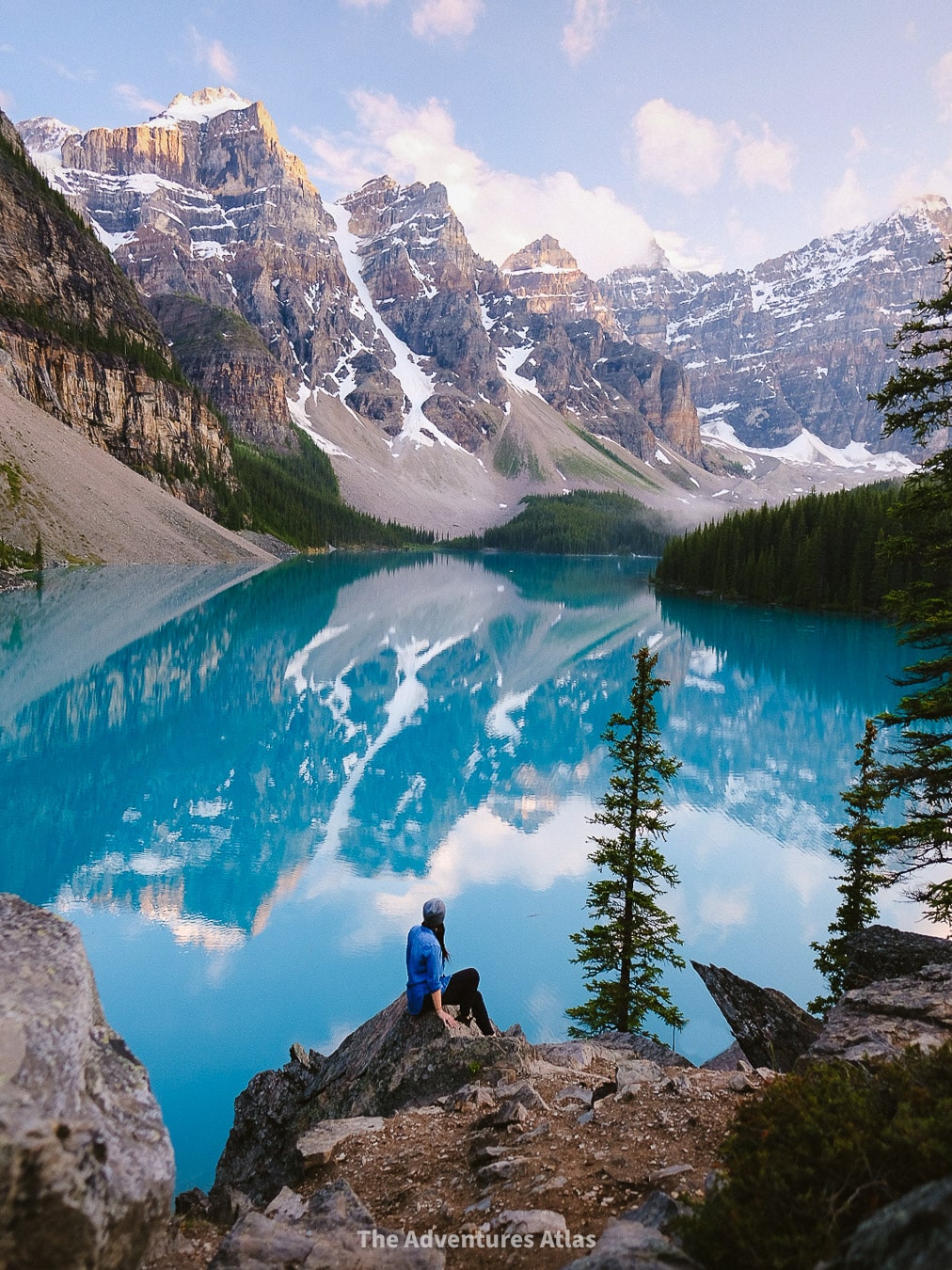
How to get to Moraine Lake in 2023
Although half the size of neighboring Lake Louise, Moraine Lake is arguably even more beautiful (if you can believe it!). For this reason, tourism has gotten out of control in recent years. And, as of 2023, you can no longer drive yourself to Moraine Lake. In 2023, Parks Canada decided to close the road to Moraine Lake to personal vehicles in an attempt to protect the environment amid the growing number of visitors.
Here’s how you can visit Moraine Lake in 2023:
- The easiest way to get to Moraine Lake is by taking the Parks Canada shuttle bus. Moraine Lake Shuttle Tickets must be booked online in advance. Reservations open on April 14 for June 1 – October 9, 2023 or you can book 48 hours before you visit. 40% of tickets for the entire season will be released at 8AM Mountain Time on April 14, and 60% will be released on a rolling 48 hour window so that you can book 2 days ahead of time. Tickets cost $8/adult, $4/senior, $2/children 7-17 years old, and free for kids 6 & under.
.
The Moraine Lake Shuttle leaves from the Park & Ride at the Lake Louise Ski Resort every 20 minutes between 6:30AM – 6PM. However, your outbound shuttle ticket assigns you a 1 hour departure window, so you can only take the shuttle between the times assigned to you. You don’t need to schedule your return trip. Return shuttles run every 20 minutes on a first-come-first-serve basis until 7:30PM.
.
The Lake Connector Shuttle from Lake Louise to Moraine Lake is also included with your Moraine Lake Shuttle ticket. So you can hop off the Moraine Lake Shuttle to visit Lake Louise on your way to Moraine Lake if you want to and then take the Lake Connector Shuttle Fromm Lake Louise to Moraine Lake.
. - Use Roam Transit’s Super Pass to go from Banff to Lake Louise via Lake Louise Express Route 8X and then transfer to the Lake Connector Shuttle to Moraine Lake. Book your pass online or visit Roam Transit for more information.
. - Book a guided tour, take a taxi from Banff, or book a shuttle via Mountain Park Transportation. This is also the only way you’ll be able to get to Moraine Lake for sunrise or sunset.
. - Bikes and e-bikes are allowed on Moraine Lake Road, but the trip is 25km round trip with 385m elevation gain.
. - The most expensive option is to shell out upwards of $1000 per night to stay at Moraine Lake Lodge, which is right on the shore of Moraine Lake.
Visit Parks Canada for the latest information on visiting Moraine Lake
Stop 3: Downtown Banff
The town of Banff is a charming little tourist town right at the foot of the mountains in Banff National Park. It’s essentially a very small collection of quaint little shops, lodges, and rustic restaurants. The town is alive with people window shopping, admiring the scenery, meeting for coffee, and browsing the farmers market, which attracts local artisans and live music.
While you’re there, I recommend taking a stroll down Banff Avenue around and grab something to eat.
If you worked up a big appetite after your hike at Moraine Lake, check out The Eddie Burger + Bar, Farm & Fire or The Bison Restaurant for hearty fare like steaks, seafood, burgers, and pizza. Make your reservations online.
For smaller plates and an eclectic Asian-inspired menu, head straight for Block Kitchen + Bar. They don’t take reservations, so try to get here before the dinner rush.
Day 4 of the best Banff itinerary: Drive the Icefields Parkway to Jasper National Park
Day 4 of your Banff itinerary takes you for a drive down the Icefields Parkway. The Icefields Parkway is the only highway that connects Banff to Jasper National Park, 230km to the north.
This highway twists and turns along the Continental Divide, through valleys of dramatic rocky peaks, thick coniferous forest, aspen stands, expansive ice fields, and lakes the color of blue Gatorade. It’s also been rated one of the Most Beautiful Drives in the World and one of the Top 20 Drives of a Lifetime (you’ll quickly see why!).
The drive from Banff to Jasper via the Icefields Parkway takes about 3.5 hours. But it’s undoubtedly an all day affair because you’ll make several tops to take pictures, explore roadside lakes, and pick your jaw up off the ground.
Budget travel tip: Gas stations are few and far between once you leave Banff, so make sure you fill up in Lake Louise. Halfway between Banff and Jasper, you’ll find gas at the Saskatchewan River Crossing. Stop here if you need to fill up and grab coffee or a snack, but be warned that the gas station is full-service only and everything inside is very expensive.

Stop 1: Peyto Lake
If you thought Moraine Lake and Lake Louise were breathtaking…just wait until you see Peyto Lake.
Peyto Lake is a brilliantly blue, fox-shaped lake that’s fed by the Peyto Glacier. Peyto Lake is best viewed from one of the popular viewpoints, where you can get a birds-eye view of Peyto Lake and part of the Wapta Icefield. The view of Peyto Lake is quite possibly the most magnificent in all of Banff National Park.
To get there, follow the Icefields Parkway about 44km northeast of Lake Louise to the Bow Summit and Peyto Lake Lookout parking lot.
The hike to the Peyto Lake Lookout starts at the parking lot. It’s a short but steady uphill walk that takes about 10-15 minutes. The trail leads to a wooden viewing platform overlooking the lake. This is the most popular lookout and gets CROWDED during the day, especially in peak season. To avoid the crowds, try to get here as early as possible or continue past the platform into the rocky clearing.
Find alternate views of Peyto Lake by hiking the Bow Lookout Trail, Observation Point, Caldron Peak and the Peyto Glacier.
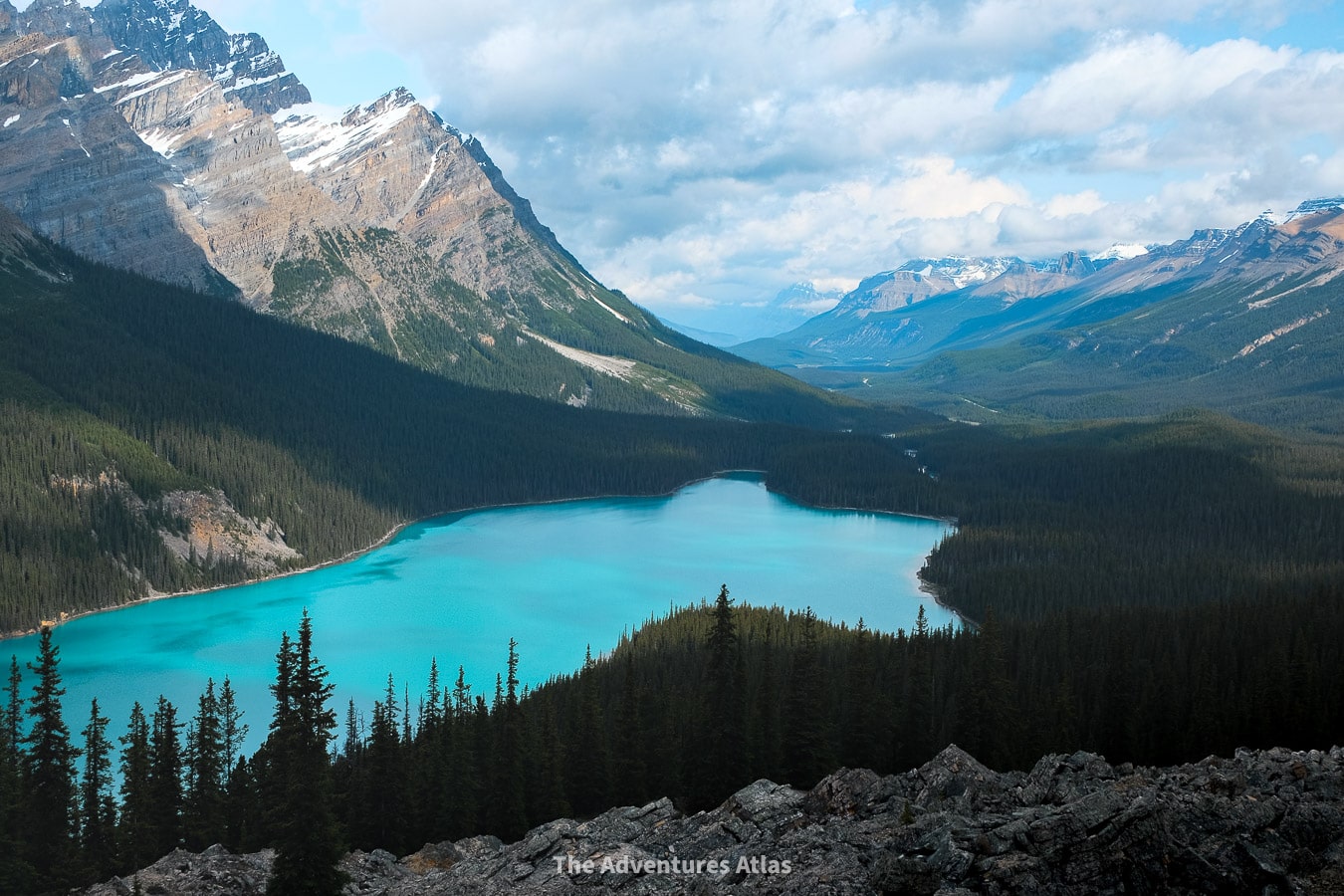
Stop 2: Athabasca Falls
Athabasca Falls is a powerful waterfall that’s formed by an enormous volume of strikingly blue water rushing through a narrow limestone canyon. The canyon was carved out by the mighty Athabasca River, which begins at the Columbia Glacier in Jasper National Park.
It’s definitely one of my all time favorite stops along the Icefields Parkway. It’s also a great addition to any packed Banff National Park itinerary (like this one) because it doesn’t take too long to see. Allow yourself about 30 minutes to explore the different viewpoints and take photos of the gorge.
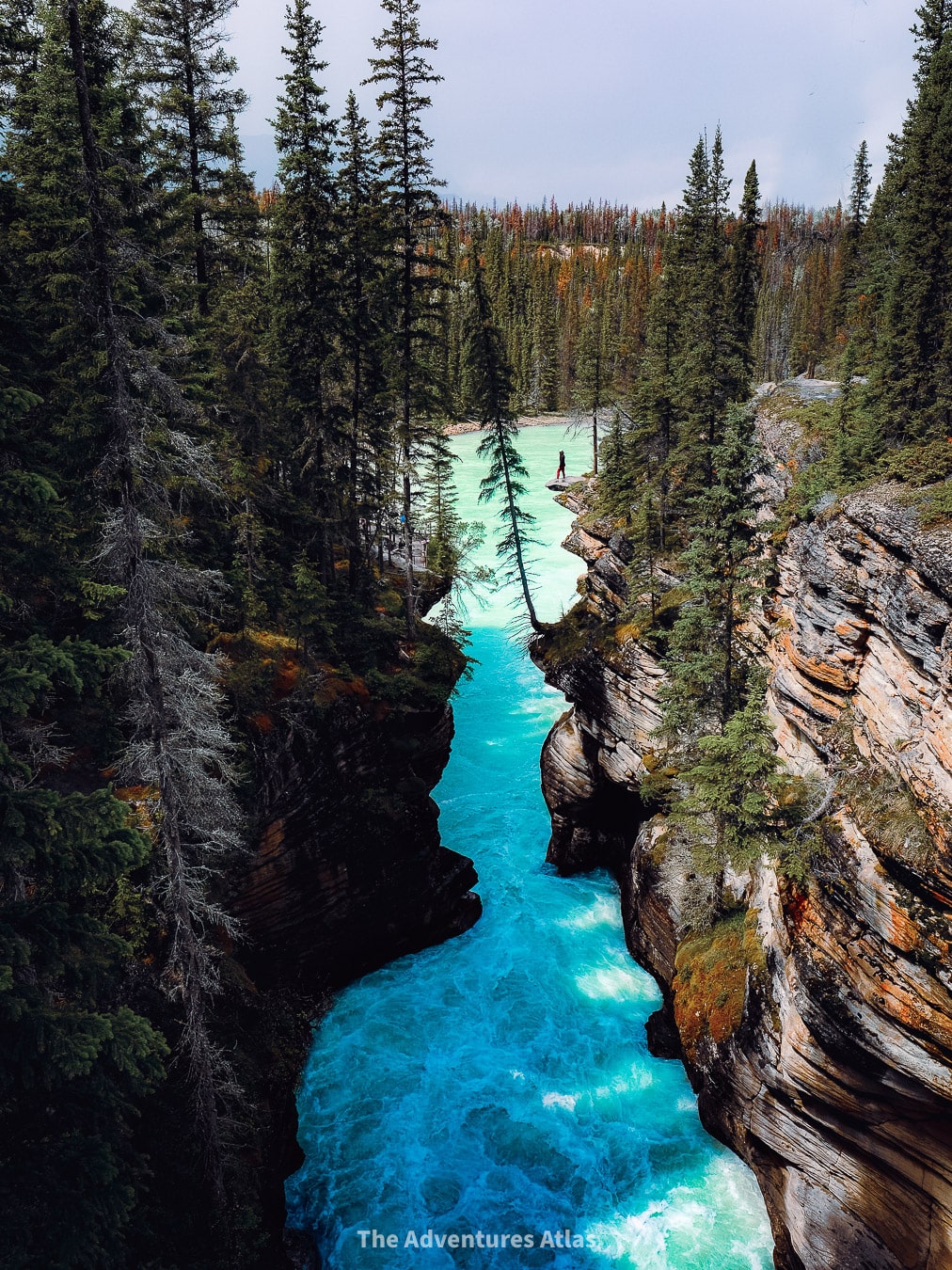
Stop 3: Sunwapta Falls
Sunwapta Falls is a series of several waterfalls that are fed by the Athabasca Glacier. They are easily accessed and make a great quick stop along the Icefields Parkway.
You can see the upper falls from a viewpoint that is only a short distance from the parking lot. The upper falls are most recognized because they encircle a small island in the Sunwapta River before crashing 18m (59 ft) into the water below.
You can stop here or follow the path 0.8 miles (1.3km) through the pine forest to reach the lower falls.
Where to stay in Jasper National Park
The biggest thing to consider when choosing a place to stay in Jasper is how much driving you’re willing to do to get to the shops and restaurants in downtown Jasper.
There are hotels right in the heart of town if you like the convenience of being able to walk to the shops, bars, and local restaurants. There are also some serene lodges and rustic hostels further out if you prefer to be surrounded by nature. Some hotels are just on the outskirts of town, while more secluded wilderness lodges are located up to an hour away. Keep in mind that if you choose a more secluded lodge, you’ll have to do a bit of driving if you want to check out a restaurant or head to the bars in town.
View all stays in Jasper National Park here.
- Splurge ($$$): Pyramid Lake Resort; Glacier View Lodge
- Moderate ($$): The Crimson Jasper; Mount Robson Inn
- Budget ($): HI Jasper Hostel; Jasper Downtown Hostel; HI Athabasca Falls
Last time we were in Banff, we stayed at Jasper Downtown Hostel and it was honestly one of the nicest hostel experiences I’ve had so far. If you’re just looking for somewhere cheap and close to town, I definitely recommend checking it out.
Camping in Jasper National Park
Camping is permitted at designated campsites in Jasper National Park.
There are 14 campsites in Jasper National Park and 9 of them are on a first-come-first-serve basis. Most sites are only open May or June through September.
The majority of campsites in Jasper National Park are unserviced, so if you need electric hookups for an RV, you will want to reserve a spot well ahead of time because they fill up fast.
View all campgrounds in Jasper here.

Day 5: Jasper National Park
At the northern end of the Icefields Parkway lies Jasper National Park. More wild, isolated, much less populated than Banff, Jasper is a UNESCO World Heritage Site and the “wildest” and largest of the Rocky Mountain parks.
Jasper National Park park is filled with expansive glaciers, tons of wildlife, and impressive waterfalls. Its also home to the world-famous Columbia Icefields, one of the world’s only Icefields accessible by road. Grizzly bears, moose, caribou, elk, and wolves roam freely. Its truly a backcountry paradise.
Stop 1: Half day hike in Jasper National Park
You only have one full day in Jasper National Park on your Banff to Jasper road trip – and you’ll want to make the most of it! So wake up for sunrise and lace up your hiking boots.
Before you hit the trails, fuel up at WickedCup in downtown Jasper. They open at 7:30AM, which is the earliest you’ll find in the area.
Choose one of these scenic hikes in Jasper National Park (open July – early Oct):
Lake Annette Loop: Easy, 1.7 mile loop, 285ft elevation gain
Mt Edith Cavell Meadows Trail: Moderate, 5.1 mile loop, 1870 ft elevation gain
Sulfur Skyline Trail: Difficult, 4.9 miles RT, 2142 ft elevation gain
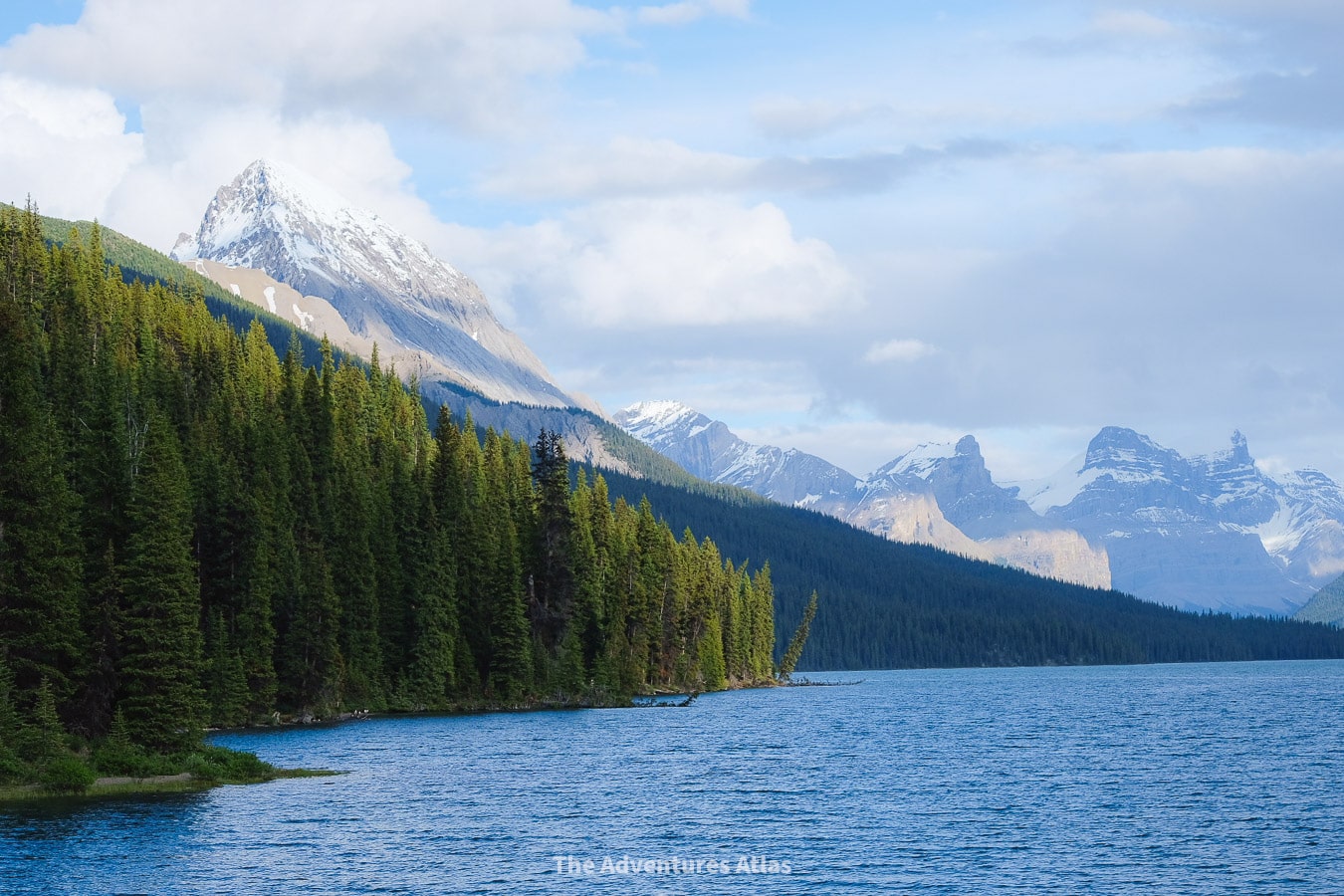
Stop 2: Lunch in downtown Jasper
If you got an early start on your morning hike, you should be done by lunch time – and likely starving!
Head into downtown Jasper for a wood fired pizza at Jasper Pizza Place. I love this place because most of their ingredients are locally sourced and they have a roof-top patio with great views of Jasper. If you’re in the mood for something a bit fancier than pizza, the Fiddle River Restaurant never disappoints.
I highly recommend walking down the street after to grab a local craft brew at Jasper Brewing Co.
After lunch, continue to Maligne Lake, which is about a 45 minute drive southeast of downtown Jasper.
The road to the lake is long and winding, guiding you past Medicine Lake and through thick forests that showcase the scars of previous prescribed burnings. Sections of forest in the park are selected year-round to be set ablaze, with the goal of restoring and improving the park’s biodiversity and keeping mountain pine beetles at bay.
Stop 3: Spirit Island, Maligne Lake (accessible June – October)
You’ve probably seen this iconic spot somewhere before, thanks to Kodak and Apple skyrocketing it to international fame. Spirit Island is now the most photographed island in all of Canada and one of the most photographed islands in the world.
But, if you can even believe it, all of those photos don’t even do this place justice. It’s even MORE magical in person, which is why taking a Maligne Lake Cruise to Spirit Island is one of the best things to do in Jasper National Park.
Boat cruises to Spirit Island depart from the dock at Maligne Lake, which is about a 1 hour drive north of Jasper town.
There are two options for a Maligne Lake Cruise to Spirit Island:
- 1.5 hour Classic Cruise; 15 minutes at Spirit Island
- 2 hour Premium Cruise; 30 minutes at Spirit Island and a stop at Pincushion Bay
If you want to take a sunset walk around Maligne Lake after your cruise, book a tour that leaves about 3-4 hours before sunset.
If you’re ultra adventurous, a strong paddler, and have two days to spare, it’s possible to canoe or kayak out to Spirit Island. Visit this post for more information.
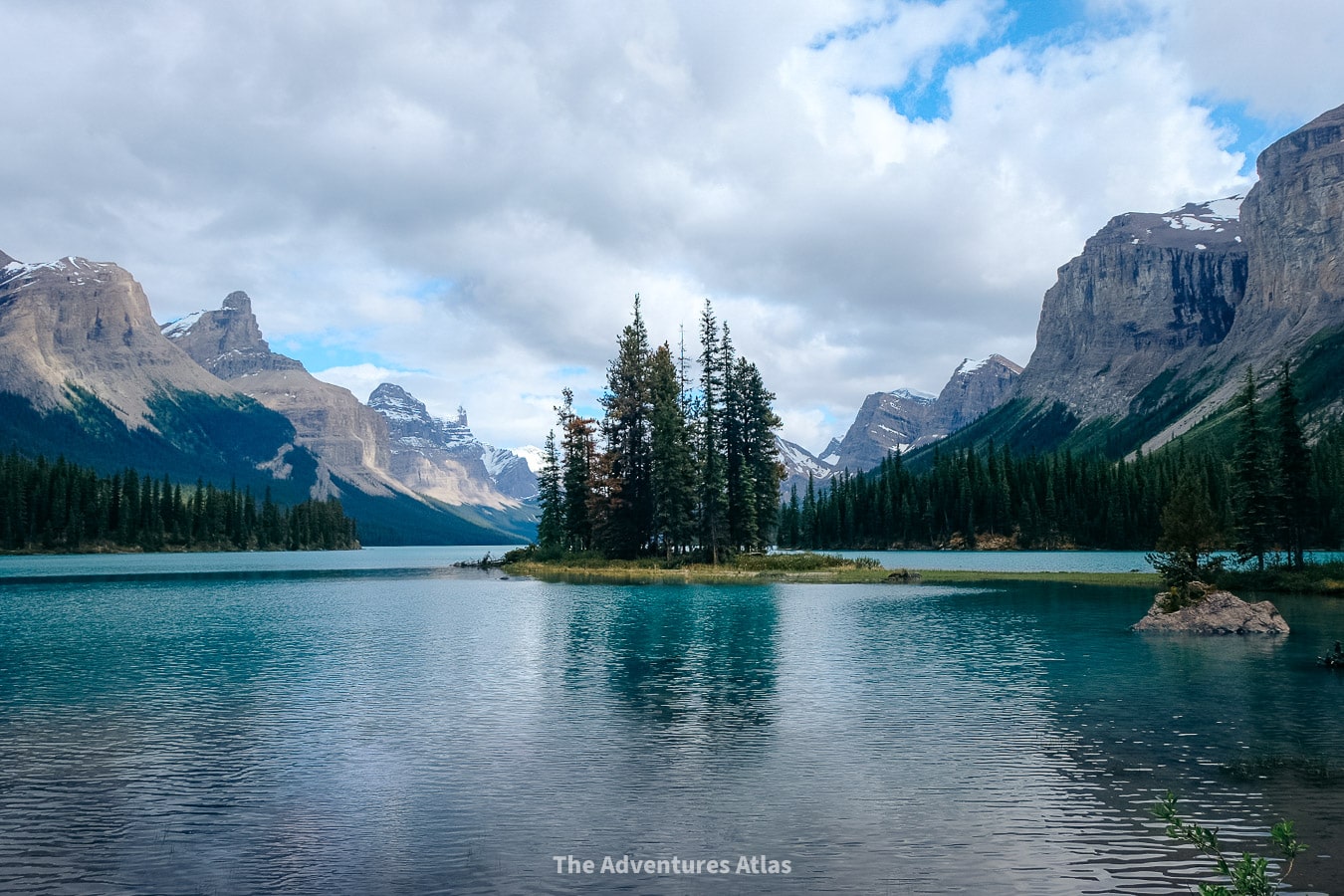
No one is certain where the name “Spirit Island” came from, but one theory is that it’s so named because it embodies the spirit of the Canadian Rockies. I’d say that’s pretty accurate, would you?
Stop 4: Sunset at Maligne Lake
After your visit to Spirit Island, I suggest meandering along the shore of Maligne lake for sunset.
Follow the Mary Shäffer Loop Trail through moss-covered forest and along pebble beaches to an open viewpoint of Mt. Edith Cavell.
Our visit there was one of my favorites. The setting sun cast a pink glow on the mountains surrounding us while the moon rose overhead. I took a deep breath and couldn’t help but feel so lucky to be there. We sat on the shore in silence for awhile while we admired our surroundings, but I could have easily sat there all night.
Here’s an overview of all the hiking trails at Maligne Lake.
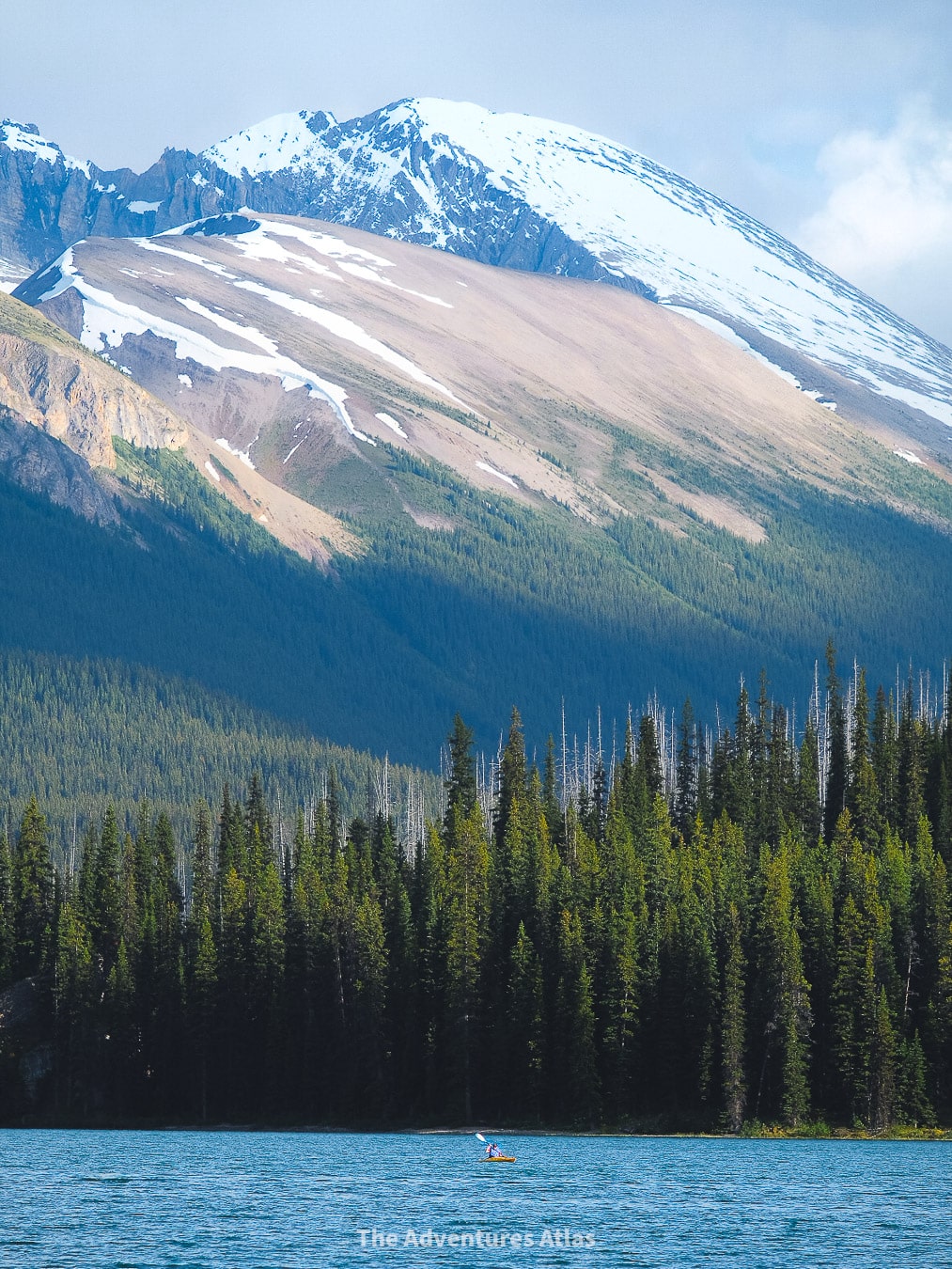
DAY 6 of 1 Week Banff to Jasper Road Trip: Drive back to Banff National Park
It’s Day 6 of your Banff to Jasper road trip and its time to head back down the Icefields Parkway toward Banff National Park.
On your way out of Jasper, take a few hours to explore the Columbia Icefield and the Athabasca Glacier.
The Athabasca Glacier is one of the best things to do in Jasper National Park. It’s definitely a must-see on your Banff to Jasper road trip because it won’t be around for much longer. Due to global warming, the Athabasca Glacier has shrunk by almost 50% in the last 125 years and continues to shrink by another 16 feet every year.
Stop 1: Athabasca Glacier
The Athabasca Glacier is one of the six main ‘toes’ of the Columbia Icefield, which sits on the border of British Columbia and Alberta, Canada. This enormous Icefield was formed over 240,000 years ago and was only discovered in the 1800’s.
The Athabasca Glacier is just one of six major glaciers in the Columbia Icefield and is flanked by two mountains: Mount Columbia to the west and Mount Athabasca on the east. This glacier is unique because it’s the most accessible glacier in North America. In fact, you can almost drive right up to the base of it!

Located at the southern end of Jasper National Park, there are two ways to see the glacier on you own:
- Toe of the Athabasca Glacier Trail: Easy 0.8 mile walk to the base of the Athabasca Glacier on a well marked trail
- Wilcox Pass Hike: Moderate 5.8 mile hike; 1712 ft elevation gain
You can’t actually walk on the glacier without a guide. The best way to explore the Icefield and see the glacier up close is to plan well ahead of time and book a tour.
The Athabasca Glacier tours only operate from May until October and start at the Columbia Icefield Discovery Centre. Some tours also include the Columbia Icefield Skywalk, which is a glass walkway that hangs out over the Sunwapta Valley.
Stop 2: Banff Upper Hot Springs
Relax at the end of the day by treating yourself to a relaxing soak in Banff Upper Hot Springs. The hot springs are the only springs in Banff National Park and are a favorite among both locals and visitors. Click here for all the details.
Day 7: Johnston Canyon via Bow Valley Parkway
One of the most iconic places to visit on a Banff National Park itinerary is Johnston Canyon and the Bow Valley Parkway.
The Bow Valley Parkway (Route 1A) is another scenic route to add to your Banff itinerary. The parkway is 50km long and connects the town of Banff and Lake Louise. The drive takes you by meadows of wildflowers, meandering streams, dramatic cliff faces, and scenic views of the Bow River.
Best roadside viewpoints (from Banff town to Lake Louise):
- Backswamp pull off
- Hillsdale Meadows
- Castle Mountain Lookout
- Storm Mountain Lookout
- Morant’s Curve
In 2022, Parks Canada approved a 3 year pilot project that closes off the eastern 17km section of the Bow Valley Parkway to vehicle traffic every day between May 1 – June 25 and again from September 1 – 30 each year. The road is closed between the Fireside Day Use Area and Johnston Canyon to allow for vehicle free cycling. If you want to go to Johnston Canyon during this time, you can cycle in or drive to Johnston Canyon via the Castle Junction exit.
Johnston Canyon
Johnston Canyon is one of the most famous stops on the Bow Valley Parkway and one of the best easy hikes on this Banff itinerary.
The views through the canyon are magnificent – emerald green pools, roaring waterfalls and the peaceful sound of the creek running through it all make it an incredible experience. What’s more, the hike is shorter than many other hikes in Banff while still offering plenty of stunning scenery along the way. Because it’s so accessible, Johnston Canyon tends to be pretty touristy. Parking is limited, so get here before 8AM to avoid the crowds or take the public shuttle.
The hike through Johnston Canyon is short, easy, and one of the most beautiful places to explore in Banff. The trail is well-maintained and leads you through lush forest and over catwalks suspended along the side of the river canyon.
The walk from the parking lot to Johnston Canyon Lower Falls is about 1.2km. The hike to Johnston Canyon Upper Falls is an additional 1.3km, one way. It takes most people about 1-2 hours to complete the Johnston Canyon hike.

Extend your Banff itinerary
Extend your Banff itinerary to include Yoho National Park.
Yoho is a small national park located about 2 hours west of Banff in the neighboring province of British Columbia. This place is truly a hidden treasure. Far less crowded than Banff, and even Jasper, but equally as beautiful.
You only need 1 day to see the highlights in Yoho. I put together this guide on exactly how to spend 1 day in Yoho National Park.
Have even more time? Tack on an extra week to explore the beautiful pacific coast of British Columbia with a 5-day Vancouver to Whistler road trip.
Getting to Banff National Park
The closest international airport to Banff National Park is Calgary International Airport (YYC), which is about a two-hour drive from the park.
To save money on your flight, you should try to book at least three months in advance – and avoid the peak season and any major holidays.
Flights are generally most expensive around Christmas and New Years, as well as between June and August due to summer vacation.
Here are the best ways to get to Banff National Park if you don’t have a car:
- From Calgary International Airport: There are a few different shuttle options, but The Banff Airporter offers cheap and flexible service from Calgary International Airport to the town of Banff.
- From Canmore: If you’re already in Canmore, you can just park there and take Route 3 on Roam Transit for a few dollars.

Parks Canada Entrance Fees
A National Park Pass is required to enter national parks in Canada, including Banff and Jasper National Park. It’s good for entry into all of Canada’s national parks.
You can purchase a Day Pass or an annual Discovery Pass. Here’s the price for adults:
- Day Pass: $10.50 per day
- Discovery Pass: $72.25 per year
You can buy a park pass online, at the park gate when you enter Banff National Park, or at the visitor Centers in Banff and Lake Louise.
The Park Pass doesn’t cover camping fees, backcountry permits, Banff shuttle fees, or day parking fees at Lake Louise.
The Best Time for a Banff to Jasper National Park Road Trip
The best time to take a Banff to Jasper road trip is June – September. These months have the nicest weather, longest days, and the most sunshine.
But be warned: this is the ultra-high season. Everything is super expensive and crowds around Lake Louise and Moraine Lake are absolutely insane after about 8AM. However, this is my favorite time to visit Banff and we never really have a problem with the crowds on longer hikes or at lesser known spots.
Shoulder season in September and October is a great alternative with lower prices, fewer crowds, but still a fair chance of decent weather. Late September – early October is the best time to see the larches turn gold. However, many places in Jasper National Park are inaccessible between October – June, so do your research ahead of time.
The best time for winter activities is December – February.
Just be aware that many facilities close October – May, so double check before you go if there’s something specific on your to-do list.
The worst time for a Banff to Jasper road trip is early spring because attractions are mostly closed and the weather is still cold and unpredictable.
Tips for avoiding the crowds in Banff National Park
Be warned that with pretty views and striking alpine lakes come the crowds. Lots and lots of them.
So, mentally prepare yourself to share popular the most popular spots on this Banff itinerary – like Peyto Lake, Moraine Lake and Lake Louise – with literal hordes of tourists flooding off tour buses, wielding selfie sticks. Sometimes the crowds get so bad that it can be hard to enjoy the views.
The best advice I can give is to arrive early in the morning or wait until around sunset to visit these attractions.
If you’re more of an early riser, arriving before 8AM will definitely give you a head start on crowds and tour buses. Don’t forget that even in midsummer, the sun sets at 10PM so that’s also a good time to go explore the park without as many people.
Another great option is to visit in the shoulder season (late September – November), when there are far fewer crowds.
If all else fails, try venturing off the beaten path and opt for longer hikes instead – this will definitely help you escape the worst of the crowds.
You might like: How to Find Secret Spots and Hidden Gems (9 Resources to Help You Find Adventure Off The Beaten Path)
What makes the water in Banff so blue?
One of the biggest draws to the Canadian Rockies is the unique color of the lakes and rivers. In Banff, Jasper, and Yoho National Park, many of the lakes turn a brilliant opaque turquoise, appearing as though someone colored it with a crayon.
The color of the lake is surreal, but the explanation lies in the geology of the Rockies. Long ago, the Rockies were shaped by glacial activity. As they moved, the glaciers eroded rock underneath them, creating fine rock silt, which remains suspended in the water column. And it’s the sunlight reflecting off the rock silt in the water that creates the iconic water of the alpine lakes.
The water is at its bluest in the summer months, as the snow melting off the glaciers carries the glacial sediment into the lakes.

How much does a 1-week trip to Banff cost?
Banff National Park tops the list as Canada’s most expensive vacation destination. So, how much money will you need for 1 week in Banff?
On average, you should plan to spend about $170 per day in Banff National Park, which totals $1190 per person for a 7 Banff National Park itinerary. This does not include the price of flights and travel insurance.
The most expensive part of your Banff itinerary is going to be lodging and your rental car.
If you want the convenience of staying at a hotel in the middle of Banff, expect to pay for it. Hotels in Banff cost between $200 – 500 per night in the low season, while hostels run a little bit cheaper at about $100 per night. However, those same hotels skyrocket in price to $350-$800+ per night in the high season.
You can save a ton of money on lodging if you stay outside of Banff, even if it’s for a few days during your Banff itinerary. Check for lodging in Canmore for a mix of affordability and convenience.
The price of rental cars average roughly $80 per day in the low season and $160 per day in the high season. Save money by booking your car about 6 months in advance.
You can expect to spend about $20-$50 on a typical meal in Banff, with food prices being the highest in Banff town.
How much I spent on a 1 week Banff to Jasper road trip in early October
- Round trip flights to YYC: $262.44
- Travel insurance: $94
- Rental car: $57.32*
- Gas: $100*
- Airbnb and hostels: $113.50*
- 1 night of car camping: $0
- Activities: $0
- Parks Canada Discovery Pass: $72.25
- Food: $187.89
GRAND TOTAL: $887.40 USD
*This total was for one person. It’s worth noting that the price of the rental car, gas, and Airbnb was split in half because there were two of us on the trip.
I’ve been to Banff several times and we chose to do this particular trip on an ultra shoe-string budget. To save as much money as possible, we didn’t treat ourselves to any splurge stays, fancy meals, or paid tours.
To keep the cost of lodging down, we stayed in hostel dorms and booked a very small Airbnb in Cochrane, which was about an hour from Banff. We also spent 1 night car camping for free at the Saskatchewan Border Crossing on the Icefields Parkway.
For food, we stocked up on groceries at Save-On-Foods before we got to Banff, which included everything we needed to make lunch almost every day – plus snacks, fruit, and protein bars. We signed up for the grocery story club card which gave us a pretty good discount.
Did you find this 1 Week Banff Itinerary and Travel Guide helpful? Let me know in the comments!
pins for your Pinterest
WANT TO SAVE MONEY TRAVELING?
Check out my list of reliable budget-friendly travel resources that are guaranteed to save you the most money, without compromising your experience.



